 |
Kevin Lippert's Radio Weblog |
|
|
|
|||||
|
|
|||||
|
|
Jordan Transmission Line Speakers for Beginners
Like a lot of things, this whole project began as a delayed adolescent wish fulfillment, courtesy eBay. In high school and college, I had been enamored of IMF speakers and their heirs, Fried speakers. Since I then had more time than money, I had several correspondences with Irving M. "Bud" Fried, who was not only happy to elaborate his feelings and findings on speaker design in personal letters, but also in a series of (it seems to me now) remarkable newsletters. "Bud" Fried was one of the original conductors on the Cluetrain: he understood the power of conversations and of elaborating his personal opinions. Some to this day feel he was trying to establish a cult of personality (judging from some nasty comments on Audio Asylum), even to the detriment of his speaker designs, but that seems a harsh judgement in retrospect. About a year ago it occured to me to look for Fried speakers on eBay, and I was able to find a beautiful pair of Studio V speakers. Although I've owned some fine speakers in the intervening years since my youthful infatuation with IMF/Fried (Dahlquist DQ-10s, Spendor BC-1s, Acoustat 2+2, Linn Kan), nothing really prepared me for the voodoo these speakers can do; listening to them is a transforming experience. But one thing about the Frieds: they are simply too large for a New York City apartment. We are blessed to have a weekend home in the country, so the Frieds moved up there, and listening became a weekend experience. My enthusiasm for stereo and its outer fringes, like Fried's transmission-line designs, rekindled, I began reading on the Internet, particularly the appealing Transmission Line website, and subscribed to the late but lamented Listener magazine. And from here, was attracted to two interesting trends (I know you're thinking: where has this guy been?): low-power tube amps and single-driver speakers, as documented and celebrated at James Melhuish's exceptional Single Driver Website. Both of these appealed to my interest in DIY (I built some Dynaco kits as a teenager, inspired by my father's Heathkit projects), which also corresponded to a new interest in woodworking (inspired by my two young sons, who go to a school that teaches woodworking starting in kindergarten!). In the process of poking around the Internet, I came across the website of North Creek Music, which has, in its founder and spokesman, George E. Short, the same kind of impassioned vision and conviction I remember in Irving Fried's old newsletters. My decision to build the Bottlehead Paramour amps, a whopping 3.5 watts, made me a bit nervous about any of the North Creek speakers, along with their "higher" cost, at least relative to rolling my own single-driver speaker. (Ultimately, I came back to North Creek, but more on this below.) However, I purchase, and highly recommend, Short's small pamphlet on speaker building, and adopted many of his ideas to the building of the Jordan TLs. One speaker which seemed immensely appealing was the Hammer Dynamics, but it's overwhelming size---4 feet tall---meant it was unlikely to pass the spousal acceptance test, so I kept looking, and came across the transmission-line version of the single-range Jordan JX92S, cabinet drawings available from the manufacturer's website, E.J. Jordan. I got my drivers ($100 each) from Creative Sound in Canada. I admit to being seduced by the Konus Audio Essence, which appears to be the same speaker as the plans on the Jordan website, and it's obvious that these were my aesthetic inspiration/goal. I should note that finished Jordan TL speakers are available from Carolina Audio (also a source of Fried-like TLs and Fried mods) and Esoteric Enclosures, who have slightly modified the design seen on the Jordan site. Building the cabinets Using North Creek's Cabinet Handbook ($5) as my guide, I built the front and back panels as a laminated sandwich of 3/4" birch plywood and 3/4" MDF, joined together with NCMS "soft glue." I made all the internal dividers of the transmission line of 3/4" plywood; these, along with the sides, were put in place with biscuits and Liquid Nails (except for yellow carpenter's glue on the biscuits) and then sealed along the edges with silicone caulking. I failed to create the speakers as mirror pairs, but since the speakers are completely symmetrical in the disposition of the driver, I did not think this was a big enough problem to rebuild an entire cabinet. 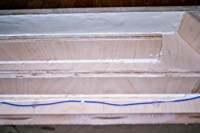 I followed North Creek's suggestion to "glop" the sides of the cabinet. Glop is a 50/50 mixture of their soft glue and drywall compound; Short claims that this helps dampen the cabinets above 300 Hz (seen here on the outside walls of the cabinets as a 1/8 to 1/4" thick layer). Rounding the driver holes  Both because I had seen in several North Creek cabinet plans instructions to round the backs of the driver holes, especially woofers, I worried that the thickness of my baffles was keeping air from flowing behind the driver, and possibly compromising bass performance (i.e., enough air wasn't flowing down the transmission line). Posts to the forum on the Single Driver Site, and emails to both Creative Sound and E.J. Jordan all confirmed that the driver hole should be rounded, so I used a 3/4" rounding bit to do this, took only minutes. In fact, Creative Sound suggested that the extra-thick baffles might be overkill: that the Jordan driver liked thin, stiff baffles (better three or four 1/4" panels of Corian or aluminum to make a laminate, than two 3/4" wood panels, they suggested: maybe next time). North Creek recommends sealing the exposed "edge" of the plywood with a layer of glue, which I did. Both because I had seen in several North Creek cabinet plans instructions to round the backs of the driver holes, especially woofers, I worried that the thickness of my baffles was keeping air from flowing behind the driver, and possibly compromising bass performance (i.e., enough air wasn't flowing down the transmission line). Posts to the forum on the Single Driver Site, and emails to both Creative Sound and E.J. Jordan all confirmed that the driver hole should be rounded, so I used a 3/4" rounding bit to do this, took only minutes. In fact, Creative Sound suggested that the extra-thick baffles might be overkill: that the Jordan driver liked thin, stiff baffles (better three or four 1/4" panels of Corian or aluminum to make a laminate, than two 3/4" wood panels, they suggested: maybe next time). North Creek recommends sealing the exposed "edge" of the plywood with a layer of glue, which I did.Fastening the drivers 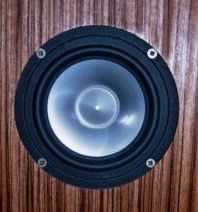 I used the excellent Precision circle cutting jig (available from Lee Valley and Parts Express) to cut the driver holes, but I cut them exactly to size, leaving virtually no room for play. In retrospect, I should have allowed an extra 1/32" or even 1/16", since the driver fit was too snug. Happily, I had ordered some square-head screws from McFeelys after seeing their ads in several woodworking magazines. They have a $10 starter pack that includes many different sizes of screws and a square head bit for your drill. I'm certain regular phillips-head screws would have stripped given the torque it took to seat the driver flush. I turned each of the four mounting screws a bit by turns, to avoid any undue stress on the driver frame, but had the feeling in the process that I was pushing my luck. So, next time: 4-5/8", not 4-9/16"! I used the excellent Precision circle cutting jig (available from Lee Valley and Parts Express) to cut the driver holes, but I cut them exactly to size, leaving virtually no room for play. In retrospect, I should have allowed an extra 1/32" or even 1/16", since the driver fit was too snug. Happily, I had ordered some square-head screws from McFeelys after seeing their ads in several woodworking magazines. They have a $10 starter pack that includes many different sizes of screws and a square head bit for your drill. I'm certain regular phillips-head screws would have stripped given the torque it took to seat the driver flush. I turned each of the four mounting screws a bit by turns, to avoid any undue stress on the driver frame, but had the feeling in the process that I was pushing my luck. So, next time: 4-5/8", not 4-9/16"! Trying them out: Bass panic 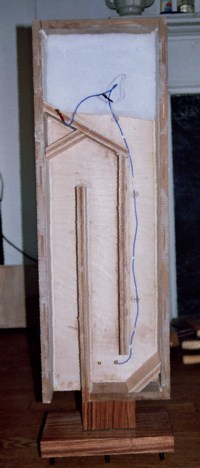 With the front baffles held in place with clamps, I fired up the speakers. Honestly, I never expected that these small drivers would conjure up the kind of bass that shakes the walls with my Frieds, but I have to say I was immediately and unhappily struck by the thin sound coming from my labors of love. I immediately started combing the web for tips on improving the bass, and came across Jon Risch's excellent rules of thumb for Classic TL Design which urges putting "reflector plates" at the bends of the transmission line. So I cut some small pieces of wood and made this minor modification from the E.J. Jordan-supplied drawings (this is done in the Esoteric Enclosures version as well). I tried adding some stuffing to the line, but could not hear any appreciable difference. I did decide that a single layer of stuffing (Dupont Dacron, again from North Creek) behind the driver sounded better (less muffled) than two or three layers, confirming Creative Sound's advice that these speakers like "air behind them". Ultimately, I left the line free of stuffing, and pushed pieces of stuffing of varying sizes up the end of the line. (At the same time, the more I read pages like Risch's, the less sure I am that this Jordan design is a "classic" transmission line in much more than its folded configuration, but I'm no expert on this...) With the front baffles held in place with clamps, I fired up the speakers. Honestly, I never expected that these small drivers would conjure up the kind of bass that shakes the walls with my Frieds, but I have to say I was immediately and unhappily struck by the thin sound coming from my labors of love. I immediately started combing the web for tips on improving the bass, and came across Jon Risch's excellent rules of thumb for Classic TL Design which urges putting "reflector plates" at the bends of the transmission line. So I cut some small pieces of wood and made this minor modification from the E.J. Jordan-supplied drawings (this is done in the Esoteric Enclosures version as well). I tried adding some stuffing to the line, but could not hear any appreciable difference. I did decide that a single layer of stuffing (Dupont Dacron, again from North Creek) behind the driver sounded better (less muffled) than two or three layers, confirming Creative Sound's advice that these speakers like "air behind them". Ultimately, I left the line free of stuffing, and pushed pieces of stuffing of varying sizes up the end of the line. (At the same time, the more I read pages like Risch's, the less sure I am that this Jordan design is a "classic" transmission line in much more than its folded configuration, but I'm no expert on this...)In retrospect, I should have given the driver a bit more time. I read a lot about "break-in," a lot of which seemed like hooey to me, but either the drivers settle down or in after a few weeks, or my ears adjusted, or I started feeding them a bit more power. And since I live in an apartment in New York City, really deep bass probably isn't called for. And although I've now embarked on building a subwoofer to complement the Jordan TLs, I'm not sure that the bass level isn't OK as-is for apartment dwellers, for people who listen mostly to folk (which, these days, is me), or people with amps that can put out a bit more than 3.5 watts. (I'm going to hook up an old integrated Arcam amp with 40 watts/channel, and see what that does, stay tuned). Gluing up the cabinets 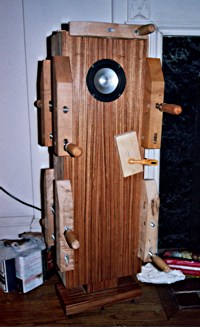 One note to beginning speaker builders: while I would consider myself an intermediate woodworker in some ways, I do not own a tablesaw, but was able to construct these cabinets with a good degree of accuracy by counting on my local hardware store to cut the plywood and MDF pieces (esp the 2-3/4" internal TL partitions) with their panel saw. If I were to make these cabinets again, I would investigate Lynn Olson's suggestion of using rabbeted grooves to slide in the front panels for the tightest possible fit with the interior partitions: here, I had to rely on a thick coating of Liquid Nails on the faces of the internal braces, along with biscuits on the edges, and hope for a tight seal. Alternately (or in addition), I did not make the back panel removable in my quest for ultimate cabinet rigidity, but doing this (probably with a dado, some sealing gasket, and some McFeely's screws) would make it possible to access the inside of the cabinets, caulk the TL tunnel to the front panel, and allow for more tweaks than I am now able to do with my rigid, but inaccessible, cabinets. One note to beginning speaker builders: while I would consider myself an intermediate woodworker in some ways, I do not own a tablesaw, but was able to construct these cabinets with a good degree of accuracy by counting on my local hardware store to cut the plywood and MDF pieces (esp the 2-3/4" internal TL partitions) with their panel saw. If I were to make these cabinets again, I would investigate Lynn Olson's suggestion of using rabbeted grooves to slide in the front panels for the tightest possible fit with the interior partitions: here, I had to rely on a thick coating of Liquid Nails on the faces of the internal braces, along with biscuits on the edges, and hope for a tight seal. Alternately (or in addition), I did not make the back panel removable in my quest for ultimate cabinet rigidity, but doing this (probably with a dado, some sealing gasket, and some McFeely's screws) would make it possible to access the inside of the cabinets, caulk the TL tunnel to the front panel, and allow for more tweaks than I am now able to do with my rigid, but inaccessible, cabinets.I used North Creek's extra-long "Big as Texas" binding posts to drill straight through the cabinet backs (1-1/2" thick!) and connect the internal wires to the driver. This I did using North Creek's Tef-Flex wire and gold-plated lugs, terminated with some shrink-tubing from Radio Shack. This kept me from having to cut or rout out a cavity for a binding cup, which I worried could compromise the solidity of the now rock-solid cabinets. Veneering 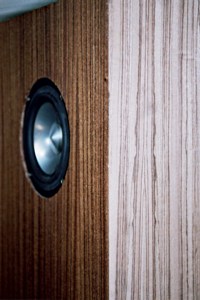 Given the number of MDF-only cabinets I've seen on the web, I thought this would be the hardest part, but it turned out to be one of the easiest and most gratifying. The book Woodworking Techniques describes a veneering technique where you brush slightly-thinned woodworker's glue onto the veneer and the subtrate (here the MDF), allow it to dry, and then iron the two together. Sounded easy enough, so I ordered some Zebra wood veneer from Oakwood Veneer Company (who sell all kinds of veneer, not just oak!). I cut the pieces slightly oversized, applied 2-3 coats of thinned yellow glue on both surfaces, then ironed them in place. I trimmed the excess with a veneer saw, and sanded the edges. The zebra wood was lighter than I imagined (see image at right, unstained on side, stained on front) so I stained it with Watco, a wipe-on oil-based stain (I used Cherry). I then finished this with several coats of tung oil, sanding with #0000 steel wool between coats. Given the number of MDF-only cabinets I've seen on the web, I thought this would be the hardest part, but it turned out to be one of the easiest and most gratifying. The book Woodworking Techniques describes a veneering technique where you brush slightly-thinned woodworker's glue onto the veneer and the subtrate (here the MDF), allow it to dry, and then iron the two together. Sounded easy enough, so I ordered some Zebra wood veneer from Oakwood Veneer Company (who sell all kinds of veneer, not just oak!). I cut the pieces slightly oversized, applied 2-3 coats of thinned yellow glue on both surfaces, then ironed them in place. I trimmed the excess with a veneer saw, and sanded the edges. The zebra wood was lighter than I imagined (see image at right, unstained on side, stained on front) so I stained it with Watco, a wipe-on oil-based stain (I used Cherry). I then finished this with several coats of tung oil, sanding with #0000 steel wool between coats. Update 9/1/03, 5 months later: The veneering process described above is not infallible, I've had some bubbling occur as the summer humidity picked up, although it seems worse in the areas where I let my kids do some of the ironing, so I suspect that pressure plays a role in making a good connection. I also found that the extra-thick veneer I ordered from Oakwood tended to bubble more than some thin veneer I bought off eBay for the subwoofer (see below)---presumably I was able to apply more heat and pressure through a thinner veneer. I finished the cabinets with North Creek's "Very Big Toes" spikes, although the "Big Toes" probably would have been fine given the 1-1/2" thickness of the base. You need a Forstner bit to drill a flat-bottom hole for the threaded inserts, and a #10 Allen wrench to drive them into the base. Anything else will destroy the inserts, as I quickly found out. The sound So how do they sound? All of the reviews of the Konus, Carolina Audio, and other Jordan JX92S-based speakers talk of their openness, and this is certainly true. They have the kind of clarity that I associate with electrostatics and other non-traditional type drivers: I love hearing details in music I didn't hear before, but some might find this kind of sound too "analytical," and detractors might call it "metallic," but I think either would be unfair. The soundstage is open and deep, although nowhere near what the Fried Studio's offer---which makes me wonder whether the built-in ambient-enhancing circuity of the Frieds (M.A.R.S.) isn't actually exaggerating the soundstage. And the coherence of the soundsource is exceptional: the vocalist stays put, doesn't wander around the room. I guess that's why people are crazy for single-driver speakers. You can boost the bass by moving the speakers closer to the wall, but this diminshes the depth of the soundstage in my opinion. Out two feet from the wall, the bass is a bit shy for my tastes, so I'm busy completing my North Creek Poseidon subwoofer (see below), and hope this will provide a wider, smoother range. I'm not sure that 3.5 watts is enough to drive this speaker to non-apartment rock-and-roll levels, although the addition of the subwoofer should take a big load off the Bottlehead amps (apparently 40% of an amp's power goes to frequencies below 100 hz). And since I have all this laminated panel left over, I'm going to build their Okara II bookshelf speakers, which should make an interesting comparison. For $300 in drivers and materials, I can't imagine a better deal than the Jordans, but the Okara's are just about the same price, and almost the complete opposite in design strategy. If you look at the speaker reviews at audioreview.com, it looks like most people love their speakers (I'd bet the average rating is just shy of 5 stars) (or you could say they love their music that happens to be coming out of their speakers). Adding on the "I built them myself" satisfaction doubles the enjoyment and, as I hope I've outlined here, is a lot easier than I imagined. But now that I've tasted the speaker-building bug, the real question is: just how many pairs of speakers does one listener need? The sound (improved) 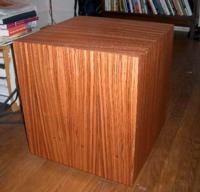 9/1/03: It took some time, but I finally completed my North Creek subwoofer; it's an easy cabinet to build, and although the interior cross-bracing is not completely clear from the diagrams (just where are those sections cut?), George Short was extremely helpful via email, and the cabinet feels like it could fall off the back of a speeding pickup and be none the worse for the wear. I found some zebrawood veneer on eBay for only a few dollars, and, in spite of, or maybe because of, being thinner than the 10 mil paper-backed veneer I bought from Oakwood, it seems to be more securely bonded to the substrate. 9/1/03: It took some time, but I finally completed my North Creek subwoofer; it's an easy cabinet to build, and although the interior cross-bracing is not completely clear from the diagrams (just where are those sections cut?), George Short was extremely helpful via email, and the cabinet feels like it could fall off the back of a speeding pickup and be none the worse for the wear. I found some zebrawood veneer on eBay for only a few dollars, and, in spite of, or maybe because of, being thinner than the 10 mil paper-backed veneer I bought from Oakwood, it seems to be more securely bonded to the substrate.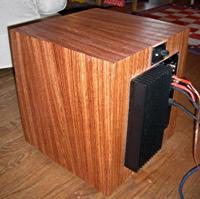 Without any modifications to the amps, I simply ran cables from the back of each speaker to the L/R inputs of the subwoofer. It has a switchable crossover, which seems to sound best at 100 Hz (which is where the Jordan starts to roll off, judging from published response curves). There is also a volume control on the subwoofer, which I have set fairly low (the amp is 250W, a lot more than the Bottleheads!). Without any modifications to the amps, I simply ran cables from the back of each speaker to the L/R inputs of the subwoofer. It has a switchable crossover, which seems to sound best at 100 Hz (which is where the Jordan starts to roll off, judging from published response curves). There is also a volume control on the subwoofer, which I have set fairly low (the amp is 250W, a lot more than the Bottleheads!).The addition of the subwoofer is illuminating in demonstrating the (psycho-acoustic?) necessity of wideband frequency response: the entire system sounds richer, fuller, and far more at ease than just the Jordans alone (or is it just the "loudness button" effect where things sound better at low volumes by bossting the bass?). Interestingly, as the Jordans break in (and as the evenings get later and I get more worried about the downstairs neighbors), I sometimes turn off the subwoofer, and continue to enjoy the music, often still with enough bass to make me fear a knock on the door. So, do you need a subwoofer to enjoy the Jordans? Probably not, especially if you live in an apartment. But if you want the full experience, the tingles and the richness that great speakers (like my Frieds) can give, I think a subwoofer is a must. Of course, this comes at a price: at $400, the subwoofer cost more than the Jordan speakers themselves. 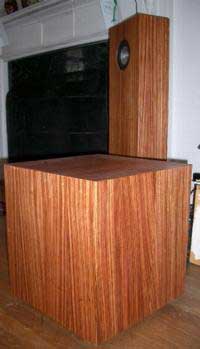 Are they better than the Frieds? I wouldn't go that far. They may be cleaner throughout the midbass and bass regions, but one mans' cleanliness might be another's thinness, when it comes to bass. Have I heard a better pair of speakers for $300 (approximate cost including drivers, plywood, MDF, veneer, and miscellaneous connectors)? Not even close. And at $700, including the subwoofer, the whole system would be pretty hard to beat, imho. Are they better than the Frieds? I wouldn't go that far. They may be cleaner throughout the midbass and bass regions, but one mans' cleanliness might be another's thinness, when it comes to bass. Have I heard a better pair of speakers for $300 (approximate cost including drivers, plywood, MDF, veneer, and miscellaneous connectors)? Not even close. And at $700, including the subwoofer, the whole system would be pretty hard to beat, imho.Questions or comments? Contact me at lippert@papress.com. Last updated 9/4/2003. |